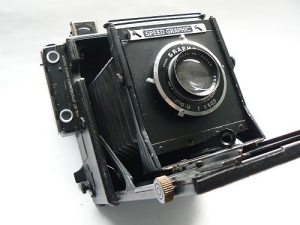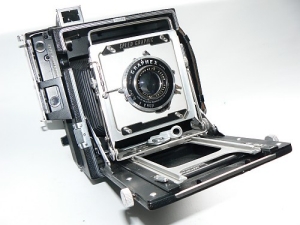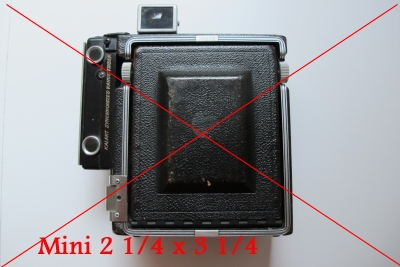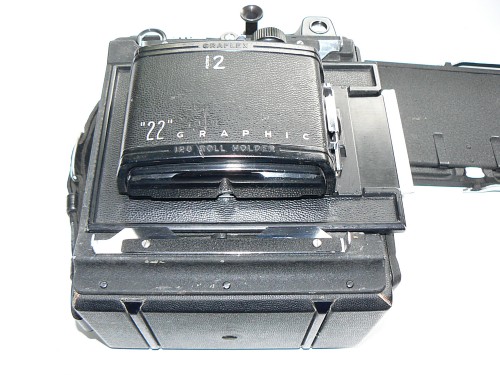

Graflex Pacemaker versus Anniversary
This
page gives a short overview to distinguish between the Pacemaker and the
Anniversary Speed Graphic as well as the compatibility for use with the 7"
Aero lens.
When not
familiar with the Graflex range of Press Cameras and not having both cameras
next to each other on the table, it could be hard to distinguish between the
Anniversary and the Pacemaker.
There
are however some eye catching differences between the Anniversary and the
Pacemaker Speed Graphic.
We'll
confine ourselves to the Post war Anniversary which is more common than other pre war
Anniversary.
Anniversary Speed Graphic


On the
left the Pacemaker Speed Graphic with aluminium lens board and on the right
the Anniversary with black wooden lens board.
Both
Speed Graphics are equiped with a focal plane shutter.
The winding key on the right side, seen from behind the camera, defines the
present of a focal plane shutter situated in the back of the camera. Such a
shutter is indispensable for the use of a barrel lens like the Kodak Aero
lens.
The most significant detail
of the post war Anniversary is the black 4x4 inch wooden lens board.
Further
black lens standard, shift and rising front, no tilt. The
Anniversary as well as the early Pacemaker Speed Graphic were equipped with a Kalart rangefinder.
Only one
slide lock on top of lens standard rather than two with the Pacemaker. The Focal plane shutter
is controlled by the famous
pre war 6 tension winding mechanism.
This
very reliable mechanic, combined with the 4 slit focal plane shutter, gives the
photographer the choice of 24 different exposure times. Twice as much than its
successor the Pacemaker, which provides only 8 different exposure times. Both
cameras have the Kalart rangefinder mounted to the right side of the camera next
to the winding key.
The
newer version of the Pacemaker Speed Graphic however, has a top mounted
rangefinder - see photo - which can be matched with other lenses just by
changing the lens cam. The predecessor of the Top Mounted Speed Graphic, the one
with the Kalart Rangefinder does not have this feature. When changing lenses it
is necessary to calibrate the rangefinder for the new lens which can be an
annoying tricky job.
The alternative would be to focus on the ground glass which is anyway the best
possible way to take the best possible shot. Another possibility is to use the
distance scale on the front of the drop bed. For fast street-work the
rangefinder is indispensable.
To be sure the
camera is a Speed Graphic
and not a Crown Graphic!
The most eye catching differences between the
Crown (left) and the Speed (right) are the focal plane shutter controls.
First of all the winding key and the Speed indicator window.
The slider which controls the use of the front shutter or the focal plane
shutter.
The flash bi-post for the connection with the flash-light.
Beside the build in release knob, no further controls can be found on the
Crown's right side.
However sometimes you'll find the flash bracket on this side.
Whether top mounted or side mounted ranger-finder is not essential, neither is
the back.
The above photo shows the left Crown which is fitted with the spring back
and the Speed Graphic which is equiped with the Graflok international back.
How to distinguish between the
"Top Mounted" and "side mounted "Pacemaker Speed Graphic.
Comparing to its predecessors, the Pacemaker cameras, were equipped with new desirable features. To start with it has a build in release knob which controls the front shutter as well as the focal plane shutter. Further more: Metal front with stainless steel U support with metal light trapping. Precision made magnesium backs and focusing panels. Four sided metal folding focusing hood. Hinged Infinity stops allowing free forward movement of front standard. Optical viewfinder with vertical and horizontal parallax correction. Build in focal plane flash synchronization. Sealed window shows focal plane shutter speeds. Tilting front. Stainless steel open sports frame finder with parallax adjustment. Interchangeable aluminium lens boards. Provision for use of focusing scales with wide angle lenses. Last but not least: In 1947 the horizontal Graphic or Graflex back was changed into the International Graflok back. This international back became world wide standard in the next decennia for all 4x5 film cassettes. You can use all sorts of film holders such as the Fuji, Polaroid 550, Polaroid 545 Kodak Readyload and all 4x5 film holders on this camera back.
Side
Mounted
Rangefinder
4x5 Pacemaker Speed
Graphic
The Pacemakers were the last Graphics build along the familiar lines. There were two types: The Pacemaker Speed "Side Mounted" and "Top Mounted". There are "side mounted" Pacemakers equipped with the Spring Back and others which are equipped with the Graflok back. Originally like all the pre-war Speed Graphic cameras, the Pacemaker Speed Graphic was equipped with a Kalart Rangefinder, mounted on the side of the camera next to the winding key. There is no feature to match the rangefinder with the lens when changing lenses. For focusing with a different lens than the standard one, the photographer should focus on the ground glass or even on a lens related focusing scale next to the track.


Photos
above show the Pacemaker Speed Graphic on the left and the Anniversary
Speed Graphic on the right.
Both equiped with the Kalart Side Mounted Rangefinder.
The Anniversary misses the build in release knob.
The Top Mounted
Pacemaker Speed |Graphic
Its successor, introduced in the late 1950's was the so-called "Top Mounted" Speed Graphic. It had a Graphic Rangefinder especially designed for the Graphic cameras (Speed and... Crown) placed on top of the housing. The principal feature of the new rangefinder is that it is instantly adaptable to any of the 9 standard lenses of different focal length. Each interchangeable cam is matched at the factory to the lens with which it will be used. Changing cams was relatively easy by exchanging the cam in the tube that couples the interchangeable lens to the rangefinder. Never the less in both cases the lens standard should be placed against the infinity stops of the related lens. Some cameras had more than one distance scale to enable working with different lenses. Beside the interchangeable cam, one would need for each lens a matching distance scale. Further more for each lens a couple of infinity stops which should be fixed on the right spot of the focusing track. The Top Mounted Speed Graphic camera is always equiped with the Graflok back.
Unfortunately there exist not such a cam for use with the 7 inch Aero lens.


Photos above show the Pacemaker Speed Graphic with the top mounted rangefinder.
_______Good to know if your Speed Graphic is suitable for use with the Kodak Aero lens._____________
whether
your camera is equiped with a Top Mounted or with a Kalart Side Mounted
Rangefinder is irrelevant
for use with the Kodak 7 inch Aero Lens.
the film size is
essential.



You must know that there are 3 different film size Pacemaker Speed Graphic cameras.
Be sure to buy the right one to fit the 7 inch Aero lens.
The 4x5 inch camera is the one on the right side. The build in release knob is situated one length from the bottom of the camera house.
The Graflok Back accepts only attachments with the raised lock rib light trap. It has a spring loaded focusing panel which pulls back to accept all Graphic sheet film holders and is instantly removable to permit the attachment of Graphic Roll Film holders by means of the Graflok slide locks.
This international back became world wide standard for all 4x5 film cassettes. You can use all sorts of film holders such as the Fuji, Polaroid 550, Polaroid 545 Kodak Readyload as well as Roll film holders on this camera back.
The
later models Speed Graphic with the Kalart side mounted rangefinder sometimes can be found
equipped with the Graflok back as well.
As from
1955 the Pacemaker Speed Graphic with the top mounted rangefinder was standard
equipped with the Graflok back.
The
Graphic Spring Back accepts
only Graflex sheet film holders which have the raised lock rib construction
which slide into the back beneath the focussing panel.
To use
the thicker accessories such as the Grafmatic holder, some spacers might be
necessary to give a bit more space between the focusing panel and the camera back.


On the
left Pacemaker Speed Graphic Camera equipped with the Graflok and on the right
a Pacemaker Speed Graphic with spring-back.
Note:
Two chrome spring clamps and two chrome slide locks on the Graflok back (photo
left) to allow to separate the complete back from the camera house while the spring back is
fixed to the camera body (right photo).


On the left Camera with Polaroid Pack Film Holder. On the right with mounted Polaroid 545 holder, both hold by the slide locks.


On the
left mounted with the 6x6 Roll film holder and on the right mounted with the
Grafmatic back.
Note:
The Grafmatic as well as the Polaroid 545 also fits to the spring back.
To remove the focussing panel of the Graflok back depress the two knurled chrome
plated supporting arms and slide the panel slightly to the right where it may be
lifted off.
To
reattach the focussing panel, fit it to the back and slide to the left, until
the arms catch beneath the hooks at the top and bottom.
Summary
To mount a 7 inch Kodak Aero lens
You need a
1) Pacemaker Speed Graphic and it is not essential whether it
is equipped with a Kalart rangefinder or a top mounted Rangefinder
2) Pacemaker Speed Graphic is the one with the winding key, little window, rear
front slide control and flash bi-post.
3) Pacemaker Speed Graphic the one with the aluminium lens standard.
4) a
JoLo Lens board